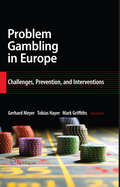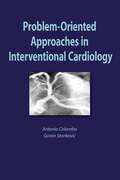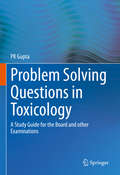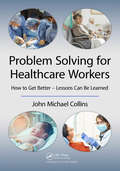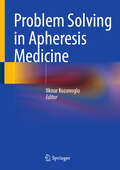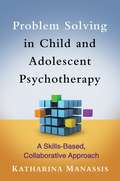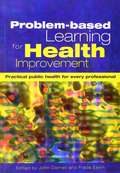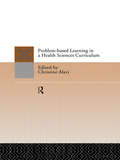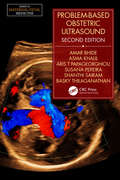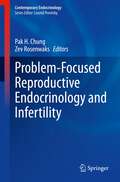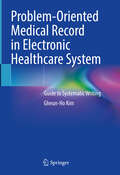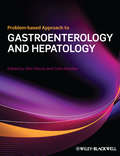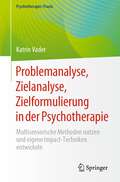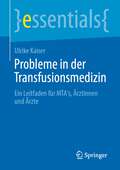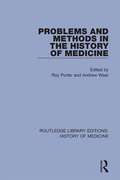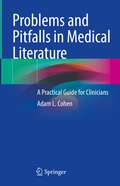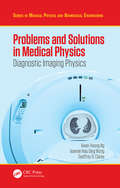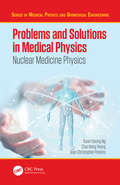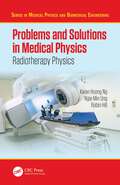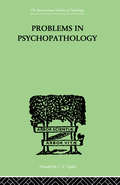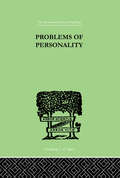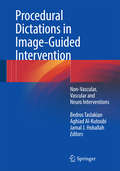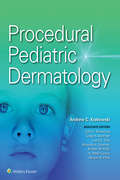- Table View
- List View
Problem Gambling in Europe
by Mark Griffiths Gerhard Meyer Tobias HayerProblem Gambling in Europe Challenges, Prevention, and Interventions Edited by Gerhard Meyer, University of Bremen, Germany Tobias Hayer, University of Bremen, Germany Mark Griffiths, Nottingham Trent University, United Kingdom As a leisure activity, gambling dates back to ancient times. More recently, the surge in avenues for gambling--casinos, sports betting, lotteries, and remote media (e.g.,Internet, mobile phone, interactive television) among them--finds growing numbers of people losing control over their gambling behaviour, usually at great personal and financial expense. Problem Gambling in Europe is the first book to offer a robust international knowledge base compiled by an interdisciplinary panel of researchers in gambling behaviour. Reports from 21 countries throughout Western, Eastern, Northern, and Southern Europe reveal wide variations in types of wagering activities, participation by populations, social and criminal consequences related to pathological gambling, the extent to which governments acknowledge the problem, and efforts to control it (often with the involvement of the gaming industries). For each country, noted experts discuss: Current legislation regulating gambling. Forms of gambling and their addictive potential. Participation rates and demographics. Prevalence of pathological gambling. National policies to address problem gambling. Prevention strategies and treatment methods. Problem Gambling in Europe brings insight and clarity to a widespread and complex phenomenon, and will be of considerable interest to all parties working to reduce their negative effects: social science researchers in addictions, gambling behaviour, and public health; clinical, social, and health psychologists and psychiatrists; treatment practitioners; the gaming industry; regulators; and policy makers.
Problem Oriented Approaches in Interventional Cardiology
by Antonio Colombo Goran StankovicInterventional operators generally expect complications when the coronary anatomy is tortuous; however, it is normal anatomy with what appear angiographically as 'regular' lesions that can cause great difficulty and additional morbidity. Drs Colombo's and Stankovic's team of first-rate, globally-recognized interventional cardiologists offer advice
Problem Solving Questions in Toxicology: A Study Guide for the Board and other Examinations
by P K GuptaThe book provides easy-to-understand diverse specialized topics in toxicology using self- study questions and answers. The answers are in the form of text along with custom made diagrams and explanations that help the student audience to understand and grasp the matter easily. It is written specifically as a study guide for the toxicology board and other examinations.
Problem Solving for Healthcare Workers: How to Get Better - Lessons Can Be Learned
by John Michael CollinsWhile most healthcare facilities have an extremely high success rate at the most challenging lifesaving work and we all know of friends and relatives who have had supreme care, mistakes are still made and patients’ lives have been put at risk and lost. How often have we heard politicians say after some disastrous report, "Lessons must be learned", but what does this really mean. Will responsible parties carry out a careful cause and effect analysis and methodically get to the root causes of the problem? Will sufficient steps be taken to permanently eradicate those causes and provide a permanent solution so that the problem will not reoccur? This is what is done in the aviation industry with the result that air travel is very safe. The low accident rate is achieved by studying the causes and using the methods of continuous improvement explained in this book. These methods are now becoming better known in the medical profession have been recommended in recent reports but are perhaps misunderstood at operational levels. This book is a basic level manual for those who have never been involved in any form of quality improvement project and is also suitable as a refresher for anyone wishing to familiarize themselves with the various techniques discussed. The aim of this book is to explain what continuous improvement is and why it’s needed; explain how individual departments can explain how and why continuous improvement is important, and helps readers recognize quality control methods in their own workplace and understand how to contribute to existing continuous improvement activities. While many of the case studies and examples are from the NHS, the author includes similar examples from around the world.
Problem Solving in Apheresis Medicine
by Ilknur KozanogluThis book is mainly about solving clinical problems in the application of medical apheresis. Unlike many other books on apheresis, it is kept short and concise. Many pictures, tables and workflow diagrams help in understanding the solutions presented.The aim is to guide professionals in transfusion medicine, pathology, haematology - oncology, neurology, rheumatology, nephrology and transplant medicine through the process of treatment and decision-making in the clinic and in their own practice. The book provides practical knowledge that can be immediately applied in patient care to optimize the apheresis treatment.
Problem Solving in Child and Adolescent Psychotherapy
by Katharina ManassisThis highly accessible book presents clear steps for helping children and adolescents to develop and test out new solutions to specific social, emotional, or behavioral challenges. The author demonstrates how therapists of any orientation can implement problem solving as a stand-alone intervention or in combination with other therapeutic techniques. Extensive clinical examples illustrate what the approach looks like in action with kids of different ages; how it increases their confidence, independence, and resilience; and ways to involve parents. Strategies for overcoming frequently encountered obstacles to problem solving are highlighted throughout.
Problem-Based Learning for Health Improvement: Practical Public Health for Every Professional
by John Cornell Frada EskinImproving the health of the population requires a public health perspective. We have written this book to demonstrate its nature. Improving the population’s health is the occupational raison d'etre of public health professionals. However, because the population’s health is affected by all facets of society’s activities (see Figure A), possessing a public health perspective is relevant to a wide variety of other professions and disciplines. Although doctors and nurses, social workers, teachers, etc., work with individuals, this book provides new insights for them to consider individuals within the wider context and offers increased possibilities for problem solving. For example, poor living conditions adversely affect school- work, dysfunctional families militate against a patient’s recovery and fear of violence on a housing estate limits the social life of an older person, which in turn creates isolation, loneliness and health deterioration. Given this broader perspective, the solution to a problem may lie in improving the wider environment rather than focusing on the symptoms exhibited by the individual. Taking a public health perspective therefore increases the opportunities for improving the population’s health and well-being. We aim to demonstrate to readers, through practical examples, the network of knowledge and skills required to tackle the challenges that daily confront all professionals concerned with people’s health. Each chapter is devoted to exploring one of the ten areas of public health competence as defined by the Faculty of Public Health Medicine.1 This has been achieved using a problem- based, self-directed learning model. Each of the chapter authors was given a broad brief but with some leeway and licence in how they presented their work. This reflects the reality of public health practice. Foreward.
Problem-Based Learning in a Health Sciences Curriculum
by Christine AlaviProblem-based learning places the student at the centre of a process which integrates what is learned in a lecture with what the student actually experiences in practice. The authors of this book use their experience of designing and implementing such a course to offer detailed examples of strategies that work, and show how the approach can be adapted to individual curriculum needs. Including key chapters on facilitation, clinical practice, assessment and evaluation, Problem-Based Learning in a Health Sciences Curriculum will be inspiring reading for all those who want to explore and extend their teaching methods and motivate their students to acquire real knowledge with enjoyment.
Problem-Based Obstetric Ultrasound, Second Edition
by Amar Bhide Asma Khalil Aris T Papageorghiou Susana Pereira Shanthi Sairam Basky ThilaganathanThis book contains a series of clinical cases that address and illustrate difficult problems in obstetric ultrasound. The approach is strongly didactic and will aid trainees in maternal-fetal medicine and obstetrics to appreciate potential pitfalls and recognize rare presentations. Each case sets out one page of text, then one of treatment algorithms, and then presents sample ultrasound scans. Learning objectives are given for each case, together with a short list of references and background reading.
Problem-Based Pain Management
by Eric S. Hsu Charles Argoff Katherine E. Galluzzi Raphael J. Leo Andrew Dubin Eric S. Hsu Charles Argoff Katherine E. Galluzzi Raphael J. Leoain management is an essential part of clinical practice for all healthcare providers from trainees, physician assistants, and nurse practitioners through to practicing physicians. Problem-Based Pain Management is a collaboration between experts in anesthesiology, geriatric medicine, neurology, psychiatry and rehabilitation which presents a multidisciplinary management strategy. Over 60 chapters follow a standard, easy-to-read, quick access format on: clinical presentation, signs and symptoms, lab tests, imaging studies, differential diagnosis, pharmacotherapy, non-pharmacologic approach, interventional procedure, follow-up and prognosis. The broad spectrum of topics include headache, neck and back pain, bursitis, phantom limb pain, sickle cell disease and palliative care. Unlike other large, cumbersome texts currently available, this book serves as a quick, concise and pertinent reference in the diagnosis and management of common pain syndromes.
Problem-Focused Reproductive Endocrinology and Infertility (Contemporary Endocrinology)
by Zev Rosenwaks Pak H. ChungIn the vast majority of books discussing reproductive endocrinology and infertility (REI), the contents are organized and classified by organs and systems. In contrast, this book is problem-based: chapters are sensibly arranged according to the chief complaints from patients presenting at the office. Readers will be guided to formulate the differential diagnoses, select the appropriate evaluation scheme to arrive at the correct diagnosis, and finally decide on the recommended treatment for the particular condition. The range of both male and female REI conditions are presented here, providing the clinician with the tools to sort through the numerous and often similar complaints from patients to reach the best treatment strategy. Discussed here are issues of puberty, menstrual conditions, uterine anomalies, fibroids, endometriosis, male and female infertility, pregnancy loss, menopause and many others. Current diagnostic and treatment guidelines and algorithms for all conditions are included, further streamlining the management process. Written by experts from the Ronald O. Perelman and Claudia Cohen Center of Reproductive Medicine at Weill Medical College of Cornell University, a world-renowned group of reproductive physicians, Problem-Focused Reproductive Endocrinology and Infertility is an indispensable resource for office-based management of REI conditions.
Problem-Oriented Medical Record in Electronic Healthcare System: Guide to Systematic Writing
by Gheun-Ho KimProblem Oriented Medical Record (POMR) has been a standard of physicians’ record since it was introduced in 1968 by Dr. Lawrence Weed. However, many physicians are unaware of its principles and do not apply it in a correct way in clinical practice. This book will describe how to systematically write medical records for the diagnostic and therapeutic approaches. This book will cover principles and practice of POMR for care of inpatients and outpatients. The importance of medical records cannot be overemphasized, but many trainees are not educated for the right way of POMR. Thus, this book will provided the right concept of POMR and correct way of medical writing, compatible with the principles of POMR.
Problem-based Approach to Gastroenterology and Hepatology
by John Plevris Colin HowdenTaking the problem-based approach, this text helps clinicians improve their diagnostic and therapeutic skills in a focused and practical manner. The cases included demonstrate the diversity of clinical practice in the specialty worldwide, and are divided into five major sections: Upper GI, Pancreato-Biliary, Liver, Small and Large Bowel, and Miscellaneous.
Problemanalyse, Zielanalyse, Zielformulierung in der Psychotherapie: Multisensorische Methoden nutzen und eigene Impact-Techniken entwickeln (Psychotherapie: Praxis)
by Katrin VaderIn diesem Praxisbuch wird der Bedeutsamkeit der Problem- und Zielanalyse und Zielformulierung in der Psychotherapie als Fundament einer Behandlung dadurch Rechnung getragen, dass sich alle Fallbeispiele auf diese Bereiche beziehen. Als passionierte Impact-Technik-Anwenderin beschreibt die Autorin jede eingesetzte Übung von der Idee bis zur Durchführung. Impact-Techniken sind multisensorische Elemente aus verschiedenen Therapierichtungen und dadurch kraftvolle und nachhaltige Arbeitsmethoden. Sie sind therapieschulenübergreifend, unabhängig vom Alter und von Beschwerdebildern einsetzbar. Attraktiv an diesen Techniken sind die Einfachheit der Durchführung und dass alle in der Umgebung zur Verfügung stehenden Gegenstände als Arbeitsmittel benutzt werden können. Durch die zahlreichen Anwendungsbeispiele von Impact-Techniken in diesem Buch soll der Transfer vom Gelesenen in den eigenen Behandlungsalltag unterstützt werden. Aus dem Inhalt: Trotz Bemühungen erreicht der Patient sein Ziel lange nicht, der Therapieverlauf stagniert trotz vorhandener hilfreicher Strategien. Verstrickungen sichtbar machen und auflösen, unklare Therapieziele konkretisieren, Therapiemotivation klären. Über die Autorin: Dipl.-Psych. Katrin Vader ist niedergelassene Psychotherapeutin für Erwachsene (Schwerpunkt Verhaltenstherapie) in eigener Praxis in Jena. Lehrpraxis, Supervisorin, Selbsterfahrungsleiterin und Dozentin für verschiedene psychotherapeutische Ausbildungsinstitute in Deutschland.
Probleme in der Transfusionsmedizin: Ein Leitfaden für MTA's, Ärztinnen und Ärzte (essentials)
by Ulrike KaiserDieses essential zeigt anhand von Fallbeispielen auffällige und pathologisches Befunde in der Transfusionsmedizin. Das Werk wendet sich an medizinisch technische Assistentinnen und Assistenten, ebenso wie an Ärztinnen und Ärzte, die noch mehr Sicherheit bei Transfusionen erlangen und bei Problemfällen gewappnet sein möchten.
Problems and Methods in the History of Medicine (Routledge Library Editions: History of Medicine #12)
by Roy Porter Andrew WearOriginally published in 1987, Problems and Methods in the History of Medicine is a collection of papers surveying and assessing the particular approaches and techniques which have been used in the history of medicine in the past or are still being developed (from the influence of Annales to the role of the computer). The emphasis is on historical practice rather than methodology in isolation. Besides the topics indicated above, a third problematic is that of historical demography. A common theme to all three groups of paper is the relation between quantitative ‘hard’ data and qualitative ‘soft’ data.
Problems and Pitfalls in Medical Literature: A Practical Guide for Clinicians
by Adam L. CohenThis book aims to teach the skills for assessing the quality of a medical article. It focuses on problems and pitfalls that may interfere with the validity of an article so that readers know what problems to look for and how to tell if an article has successfully addressed them. It focuses on concepts rather than formulas. In each chapter, one article will be analyzed to illustrate a particular concept, demonstrating when to look for that pitfall, how to recognize it, what effect it would have on results, and how to tell if an author has successfully mitigated the pitfall. Written with clarity and precision, this invaluable resource ensures that readers develop a deep understanding of the critical elements that underpin the quality of medical literature. Each chapter presents a specific concept and employs a practical approach, utilizing the analysis of a real-world medical article to illustrate the concept in action. By dissecting the research, readers learn to identify common pitfalls, recognize their influence on the results, and determine whether the author has effectively addressed them. By exploring topics such as research methodology, bias detection, and result interpretation, Problems and Pitfalls in Medical Literature empowers readers to go beyond a superficial understanding of articles and critically evaluate their reliability and relevance.
Problems and Solutions in Medical Physics: Diagnostic Imaging Physics (Series in Medical Physics and Biomedical Engineering)
by Kwan Hoong Ng Jeannie Hsiu Wong Geoffrey D. ClarkeThe first in a three-volume set exploring Problems and Solutions in Medical Physics, this volume explores common questions and their solutions in Diagnostic Imaging. This invaluable study guide should be used in conjunction with other key textbooks in the field to provide additional learning opportunities. It contains key imaging modalities, exploring X-ray, mammography, and fluoroscopy, in addition to computed tomography, magnetic resonance imaging, and ultrasonography. Each chapter provides examples, notes, and references for further reading to enhance understanding. Features: Consolidates concepts and assists in the understanding and applications of theoretical concepts in medical physics Assists lecturers and instructors in setting assignments and tests Suitable as a revision tool for postgraduate students sitting medical physics, oncology, and radiology sciences examinations
Problems and Solutions in Medical Physics: Nuclear Medicine Physics (Series in Medical Physics and Biomedical Engineering)
by Kwan Hoong Ng Chai Hong Yeong Alan Christopher PerkinsThe second in a three-volume set exploring Problems and Solutions in Medical Physics, this volume explores common questions and their solutions in Nuclear Medicine. This invaluable study guide should be used in conjunction with other key textbooks in the field to provide additional learning opportunities. Topics include radioactivity and nuclear transformation, radionuclide production and radiopharmaceuticals, non-imaging detectors and counters, instrumentation for gamma imaging, SPECT and PET/CT, imaging techniques, radionuclide therapy, internal radiation dosimetry, and quality control and radiation protection in nuclear medicine. Each chapter provides examples, notes, and references for further reading to enhance understanding. Features: Consolidates concepts and assists in the understanding and applications of theoretical concepts in medical physics Assists lecturers and instructors in setting assignments and tests Suitable as a revision tool for postgraduate students sitting medical physics, oncology, and radiology sciences examinations
Problems and Solutions in Medical Physics: Radiotherapy Physics (ISSN)
by Kwan Hoong Ng Robin Hill Ngie Min UngThe third in a three-volume set exploring Problems and Solutions in Medical Physics, this volume explores common questions and their solutions in Radiotherapy. This invaluable study guide should be used in conjunction with other key textbooks in the field to provide additional learning opportunities.One hundred and forty-four solved problems are provided in ten chapters on basic physics topics, including: External Beam Therapy Equipment, Photon Beam Physics, Radiation dosimetry, Treatment Planning for External Beam Radiotherapy, and External Beam Commissioning and Quality Assurance.Each chapter provides examples, notes, and references for further reading to enhance understanding.Key features: Consolidates concepts and assists in the understanding and applications of theoretical concepts in medical physics Assists lecturers and instructors in setting assignments and tests Suitable as a revision tool for postgraduate students sitting medical physics, oncology, and radiology science examinations
Problems for Biomedical Fluid Mechanics and Transport Phenomena
by Mark Johnson C. Ross EthierHow does one deal with a moving control volume? What is the best way to make a complex biological transport problem tractable? Which principles need to be applied to solve a given problem? How do you know if your answer makes sense? This unique resource provides over 200 well-tested biomedical engineering problems that can be used as classroom and homework assignments, quiz material and exam questions. Questions are drawn from a range of topics, covering fluid mechanics, mass transfer and heat transfer applications. Driven by the philosophy that mastery of biotransport is learned by practice, these problems aid students in developing the key skills of determining which principles to apply and how to apply them. Each chapter starts with basic problems and progresses to more difficult questions. Lists of material properties, governing equations and charts provided in the appendices make this a fully self-contained work. Solutions are provided online for instructors.
Problems in Psychopathology
by T.W. MitchellFirst Published in 1999. Routledge is an imprint of Taylor & Francis, an informa company.
Problems of Personality: Studies Presented to Dr Morton Prince, Pioneer in American (International Library Of Psychology Ser. #Vol. 4)
by C. Macfie Campbell H. S. Langfeld Wm Mcdougall A. A. Roback E. W. TaylorThis is Volume IV of a series of twenty-one on Individual Differences. Originally published in 1925, this is a collection of essays and studies presented to Dr Morton Prince, pioneer in American psychopathology.
Procedural Dictations in Image-Guided Intervention
by Jamal J. Hoballah Bedros Taslakian Aghiad Al-KutoubiThis book is designed to provide the practicing interventionist with a comprehensive list of procedural reports that covers the vast majority of the currently performed interventional procedures outside the cardiac system. It offers up-to-date explanatory notes, synopsis of the indications, contraindications and potential complications in an organized and practical format that follows the various body systems and progresses from the simple image guided FNA to the most complex procedures and incorporates the current societal guidelines. The book is divided for ease of reference into three main parts: Non vascular, Vascular and Neurovascular interventions. This information is not currently available in any single publication. The text provides residents, fellows as well as staff members with a quick, detailed and user-friendly resource for documentation of image-guided interventional procedures that will facilitate their tasks, improve the standard of documentation and reduce errors. The text can serve as a valuable tool for a quick review prior to a procedure or in preparation for an oral board certifying examination. The entries are vetted by recognized experts in the field of image-guided intervention. Procedural Dictations in Image-Guided Intervention: Non-Vascular, Vascular & Neuro Interventions covers the vast majority of the currently practiced image-guided interventions in the various body systems. This information is supported by up-to-date references and international guidelines. This book is a must-have for residents and fellows undergoing training and all specialists in image-guided intervention.
Procedural Pediatric Dermatology
by Andrew C KrakowskiMany factors contribute to the challenge of performing dermatologic procedures in children including the use of different instruments, skin differences, patient and parental anxiety, pain management and anesthesia, and the need to optimize outcomes over the lifetime of the patient. Procedural Pediatric Dermatology is a first-of-its-kind reference that provides thorough, step-by-step instruction for over 100 dermatological procedures specific to the pediatric population. Using a multidisciplinary, practical approach, this unique title equips today’s clinicians to perform safe, effective care to children with guidelines and clinical pearls/tips for pre-, intra- and post-procedure strategies in addition to coding and insurance guidelines.
